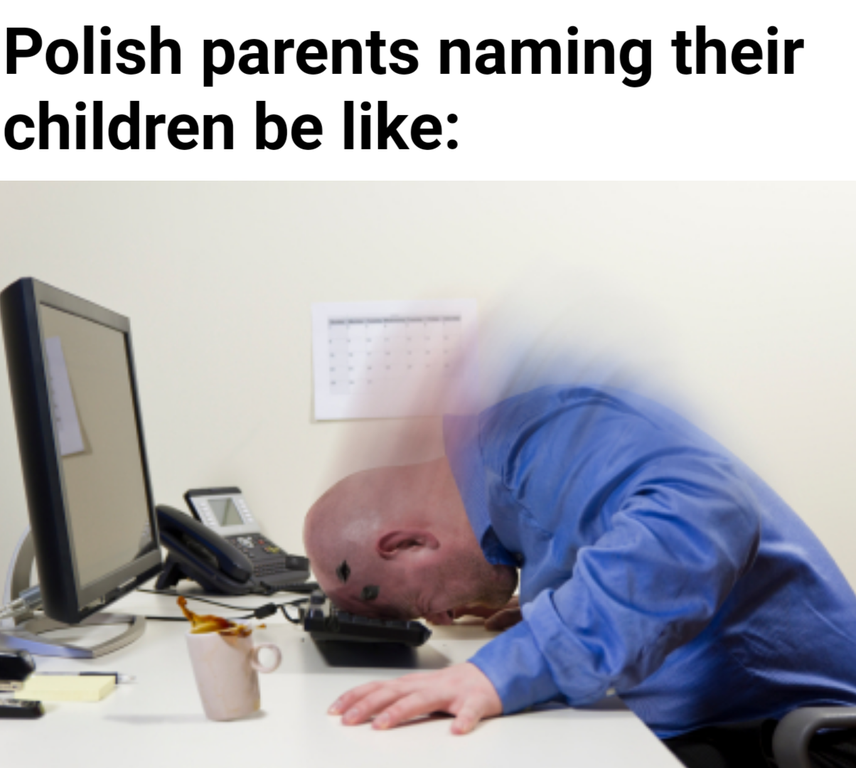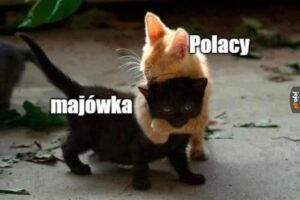
Everything you need to know about Polish names
History of Polish Names
The Oldest Polish names are of Slavic origins. Firstly there were so-called common names. They were not abstract or made up, but rather connected to common things that were familiar to people of that time. They mostly referred to:
- occupation: Kowal – blacksmith
- place (of origin, of living, etc.): Lasota – the one who lived in the forest (forest-las)
- personal features: Charnula- the one who had black hair (black- czarny) or Białowąs – someone who had a white mustache (white- biały, mustache-wąs)
- animal: Lis- fox
- plant: Jawor- sycamore
The majority of common names didn’t last till our time. Some of them disappeared, some lost or moved their function- for example, became surnames (like the former name Kowal became the surname Kowalski, Jawor became Jaworowicz, etc.). Only a few still exist in their primary forms, mainly the ones related to plants: Róża (rose), Kalina (viburnum).
The second group of oldest types of names was double-barrelled names. They were also very old, some of them came even from Proto- Slavic times and were rather used for upper-class society (for example name Bolesław – bardzo+sławny = very+famous, was used only within the royal family until the XV century). Peasants were rather called by common names. The majority of double-barrelled names had a meaning, they consist of two words that grew into one name. Usually, they’ve had a “wishing function”, their meaning was expected to shape the bearer’s future or their characteristic (Radogost – radosny + gościnny = cheerful + hospital). Many of them remained till our times and are still popular, for example, Sławomir, Kazimierz, or Bogdan.
In the old times, names were not given to the child after birth, as we do now. In the Pegan Slavic culture, the name must have been owned with time. The child was given a name usually at the age of 7. For boys typically during the ceremony called postrzyżyny- ceremonial hair cutting. Along with the haircut, the child was receiving a name and becoming an official part of family and society, moving from mother’s to father’s guidance.

There is no agreement among scholars whether the child was officially given a name that he was anyway using till that time or a new one was given. Among the second group, the most common is the idea that children till ceremonial hair cutting were called by some kind of subsidiary name like “Niemój” (nie+ mój = not+mine) which had a magical function and was serving as a shield from demons and ghosts. By showing the irrelevancy of the child it was aimed not to attract bad spirits’ attention. It surely had also an unintentional psychological aspect- the death rate among newborns and small children was at that time very high. Postrzyżyny were ceremonies mainly for boys, girls’ names were usually given more privately without such a big protocol.
Keeping in mind postrzyżyny and old Slavic rituals may help us to remember the Polish phase “Jak masz na imię” much better, as it will make much more sense now. In Polish, we don’t ask like in the majority of other European languages, “What is your name”, instead of the verb to be, in Polish we use the verb to have in this sentence, the name is not something that just is, it is something that we have, own.
What might be interesting in old Slavic culture no names are referring to Pagan Gods, most likely that was a taboo subject and a sacrum sphere not brought up in common, everyday situations.
Contact us if you have any questions!
The spread of Christianity on Polish land (after 966) brought with itself Christian names which with time started slowly displacing old Slavic ones. New names come from the Old and New Testament, especially popular were names of Apostles, Saints, or Martyrs (Jan, Mateusz, Cecylia, Urszula). It was never a practice to give children the religious name Jesus (Jezus), and up to the XIX century, Mary (Maria) was extremely rare.
Christian names are still very popular, they are continuously the biggest group among modern Polish names, but usually, they do not bring up religious connotations anymore.
Another category of Polish names is the names inspired by culture– mainly from literature. We have a few of them which came into usage in different periods, for example, Oskar or Malwina were coming from The Works of Ossian; Grażyna was the name created and used by Polish poet Adam Mickiewicz in one of his works.
The XX century started the period of loanwords names. Many new names (or modified ones) appeared as a result of the influence of English, German or Russian. Examples of such names are Żaneta, Nikola, and Dżesika– there is a variety of spelling, mainly depending on the wish of the parents who are giving it to the baby.
Grammer Rules of Polish Names
One of the easy things in Polish is the fact that by knowing the name we can usually guess the gender of the bearer. Names ending with -A is in 99 % female names (with exception of foreign names and very few rare male ones like Kosma or Dyzma). It is a good tip to remember the gender of nouns in general. The vast majority of feminine nouns will end with -A, the same as Polish girls’ names. This rule is very visible in pairs of names which we have several in Polish, the same name may have two versions:
- Kamil (masculine) Kamila (feminine)
- Karol (m) Karolina (f)
- Bogusław (m) Bogusława (f)
Unfortunately, this rule only applies when the name stands in Mianownik– Nominative, primary case. If it’s being declined by any other case it can have a variety of endings and -A is no longer reserved for feminine ones. Take a look:
To jest Maciej a to jest Anna.(Nominative- Mianownik)
Nie ma Maciej A i nie ma AnnY. (Genitive- Dopełniacz)
Diminutives for Polish Names
Polish loves diminutives. It is not a surprise that we have many possibilities to use the diminutive form regarding Polish names as well. Let’s take a look at general rules and ways how we can do that:
- by shortening the name: Alicja – Ala, Elżbieta– Ela. Maksymilian– Maks, Tomasz– Tomek, Stanisław– Staś, these may seem quite obvious but we have a bit more complicated, perhaps ridiculous as well: Aleksander – Olek, Joanna– Asia, Katarzyna– Kasia
- by adding -ka and/or -usia to feminine names: Maja– Majka- Majusia, Dorota – Dorotka,
- by adding -uś, -iś, -yś to male names: Krzysztof– Krzyś, Jacek– Jacuś and -ek Jan-Janek, Zbigniew– Zbyszek or rarely -o: Ryszard – Rysio
What is interesting diminutive forms of names are not used only to address children or reflect very close relationships as it may seem. Poles very often use only diminutive versions of their names in everyday life, sometimes even to strangers. It is very likely that the newly met girl will introduce herself as Kasia instead of Katarzyna to you, or the boy will always sign emails as Tomek instead of Tomasz. That is a cultural thing and must be “felt by intuition” or just practice as some names will never work in a diminutive for stranger adults while others are barely never used in their basic form. If you will address newly met Anna as Ania that will most probably be completely fine but if you try the same with Karolinka instead of Karolina it will be quite strange. That comes from the fact that diminutives from some popular names are used so often that they barely lose their diminutive character and are perceived as standard names without their emotional baggage.
Learn more about Egzamin Certyfikatowy z Języka Polskiego – B1
My favorite and as well very Polish connection is diminutive name form combined Mr or Mrs (Pan, Pani). By doing so we will receive so interesting, and rather very odd for foreigners, constructions as Pani Zosia (from Zofia) or Pan Remek (from Remigiusz). Most likely such combinations will be used in a situation when you are maintaining with someone rather formal relation (don’t want to resign from using formal Pan/Pani expressions) but at the same time, you want to show your sympathy or kindness towards the person. As an illustration: I’m always calling the administrator of the building in which I live Pani Hania (from Hanna). I do so because she is much older than me, therefore I want to keep formal and in this case, showing some respect form Pani, but at the same time I see her everyday for a couple of years already, she is not a stranger to me anymore and by using Hania I feel like I’m showing my warm feelings towards her.
Popular Names in Poland
The popularity of names changes every couple of years. A few years ago there was a period when names of foreign origins were very popular, for example, Nikola or Oliwia. Nowadays there is a trend to come back to older names like Antoni or Franciszek.
- In 2020 most popular names given to girls were: Julia and Zuzanna, to boys Antoni and Jan.
- In 2021, the most popular Polish names for boys were same as the previous year, but Zuzanna and Zofia were top names for girl.
- In 2022, Jan and Aleksander were the top names for boys, Zofia and Zuzanna were the most popular girl names in Poland.
You can view the lists here at dane.gov.pl website, the most popular Polish girl names and the top Polish names for boys in Poland
When I was looking at my family tree, the name Antoni and Rozalia were present almost in every generation for dozens of years. In the past it was quite popular to name the first son after the father as well, now it is quite rare due to practical reasons.
What is Name Day – IMIENINY?
 A name day (imieniny) is a custom connected to Roman Catholic and Eastern Orthodox church and originated with the Christian calendar of saints. It is celebrating a day of the year that is associated with one’s given name. Whose name day is today can be easily checked as almost every calendar has such information, it is also part of everyday radio or tv morning news.
A name day (imieniny) is a custom connected to Roman Catholic and Eastern Orthodox church and originated with the Christian calendar of saints. It is celebrating a day of the year that is associated with one’s given name. Whose name day is today can be easily checked as almost every calendar has such information, it is also part of everyday radio or tv morning news.
A few decades ago name day was celebrated in Poland even more festive than a birthday. Nowadays it changed and it is mostly being celebrated by a bit older generation. What might have had an influence on such a shift was the growing popularity of Facebook and similar social platforms. Before people didn’t know the birthday dates of more distant friends or colleagues therefore they celebrated and prepared gifts and wishes for name days which could be easily checked in the calendar. With Facebook becoming popular, birthday dates became public knowledge and name-days are slowly sinking into the shadows of forgotten traditions.
In 2015 laws in Poland have changed. Before it was not possible to give a child a foreign name if both parents were Polish. The name could have been of foreign origin but not foreign spelling or pronunciation, so it wasn’t allowed to name daughter Sophie (Zofia was ok though), not Ann but Anna, not Pedro but Piotr. After the change parents now have more possibilities to choose from, fully foreign names are allowed. Parents can use their imagination with exception of offensive or shaming names.
Photo copyright:
https://ahseeit.com/?qa=77399/polish-parents-naming-their-children-be-like-meme
www. mojewronki.pl/2016/01/dzien-dobry-wronki-19/kartka_z_kalendarza_19-01/
www.blog.slowianskibestiariusz.pl/swieta/postrzyzyny/

 A name day (imieniny) is a custom connected to Roman Catholic and Eastern Orthodox church and originated with the Christian calendar of saints. It is celebrating a day of the year that is associated with one’s given name. Whose name day is today can be easily checked as almost every calendar has such information, it is also part of everyday radio or tv morning news.
A name day (imieniny) is a custom connected to Roman Catholic and Eastern Orthodox church and originated with the Christian calendar of saints. It is celebrating a day of the year that is associated with one’s given name. Whose name day is today can be easily checked as almost every calendar has such information, it is also part of everyday radio or tv morning news. 


1 Comment